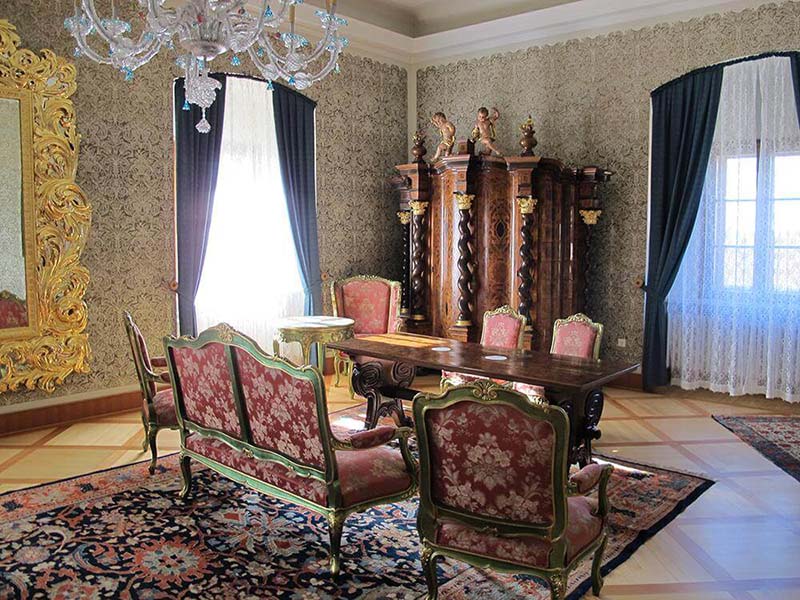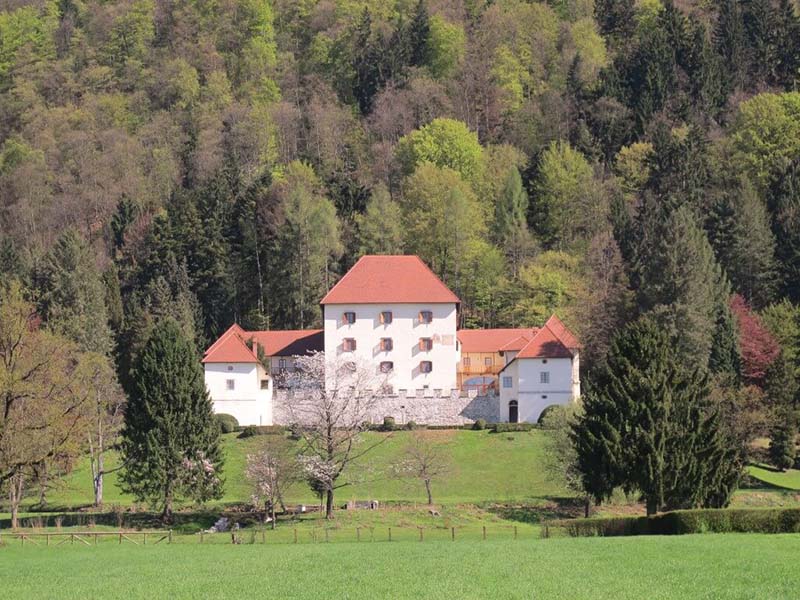STRMOL CASTLE

Among the oldest
Of the twelve middle age castles on the area of the nowadays municipality the castle Strmol is the only preserved one till today. Today, if you drive along the road connecting the village Češnjevek and Dvorje you may see under the hillside of the Cerklje’s forest its magnificent image.
The castle is among the oldest in the area. In the literature it is first mentioned in 1287. Its owner was Verijand Strmolski, who had held the castle until 15th century, then the owners changed often, among the last ones was the industrialist Rado Hribar from Ljubljana.
Cultural monument
Today, it is a registered object of the Republic Slovenia. In 2004 it was declared a cultural monument of national importance.
Below the castle was once a pond with a lifting bridge, which was a shield against invasions of Turks, today we find underneath there a designed artificial lake. The castle is beautifully preserved, with the park it is a well maintained and picturesque whole, placed at the foothill of Dvorjansko hill. The core of the castle is a tower building with a late medieval core, in its current form it was formed in late Renaissance and Baroque period.
The central building is surrounded by low four angled walls of a square of the renaissance, strengthened with square corner towers. Entrance portal on the northern facade is decorated with two atlantes, which are in the park made by sculptor Angelo Putta - Pozza.
Rich collection
The castle holds a rich collection of historical furniture, paintings and other antiquities. The concept of the park’s design around the castle comes from the 17th century, its main parts are the treacly designed parterre on the south side of the castle, which goes over to the grass plains with a fallow-shaped lake, and an accessible lime avenue on the west side.
The entirety is completed by flat fields and Dvorjanski hill in the background. The park is equipped with fountain and baroque plastic brought from the former castle Zalog pri Moravčah.
Church of St. Spirit in Češnjevek was built in 1833. The original church was built up in 1535, of it only a bell tower has remained. All three altars are the work of Aleš Janežič hosts, but the main one was later reshaped.
Češnjevek is a village, where on its edges some decades ago still bricks were manufactured. Caves were clay was mined, were watered. This has created several ponds.
The history
The castle of Strmol is one of the oldest and best preserved castles in Slovenia. The knights of Strmol were first mentioned in the 13th century while the castle itself can be tracked back to 1287 when it was first mentioned.
The original floor plan including its four towers has been well preserved upon to the present day due to restorative and other architectural works conducted in its past.
In 1412 documents mention Jakob von Strmol and his wife Adel. At the end of the 15th century the owners of the castle became the Raini. On the 20 September 1479, Strmol was given as a fief to Georg Rainer by the Emperor Friedrich III. The Raini remained in possession of the estate until the year 1634 when Jakob Georg sold it to Franz Christoph von Schwab. In the first half of the 17th century, the castle of Strmol was bought by the baron von Hussenstein who strengthened the original ramparts and the four towers. He also changed the interior of the castle and added living rooms to the already existing military facilities. The castle was thus made inhabitable. After baron Hussenstein and his wife’s death, the castle was inhereited by their son Heinrich. He was a passionate explorer of the region, where he even discovered gold.
In the 18th century iron was mined on the periphery of the basin at Strmol and Velesovo. Later research confirmed the existence of ores and minerals in the hilly area behind the castle although not in quantities sufficient to make systematic exploitation reasonable.
In the following decades the castle was handed over from one owner to another among them was baron Michelangelo Zois whose ownership only lasted for a year. He bought the castle in April 1768 and sold it in April 1769 to Franz Xaver Dietrich bought it for 19 000 florins. The domain of Strmol was then auctioned off in 1843 by Alojz Urbančič, for the price of 23 100 florins. It was from his successors and heirs that the domain and the castle were again bought in 1899 by Jožef Jenko, a teacher and landowner from Grad pri Cerkljah. Between the two wars, the castle was owned by the Fuchs family who sold it to Rado Hribar an industrialist from Ljubljana. After WW II the castle of Strmol was nationalised and today it is run by the Government of the Republic of Slovenia.
The castle and its surroundings with a like fit harmoniously into the background scenery and offer beautiful view. A healthy climate and sumptuous comfort of the castle’s interior make Strmol an ideal place for rest and active relaxation. The parks carefully laid out and looked after, as well as rich interior including period furniture and paintings from the National Gallery conjure up an atmosphere of the past where the present fades into history and history becomes the present.
Due to exceptional cultural, artistic, architectural, historical and landscape features the Strmol castle was declared as a cultural monument of national importance.
Even today, Strmol castle offers a different kind of living. Guests can stay in one of eleven authentic castle rooms and suites. Castle represents an ideal location for business or private meetings. In smaller business spaces near the castle there are smaller conference facilities, where it is possible to organize a multi-purpose event.

More information: Grad Strmol


